

By Ole Kreiberg
The idea of an Aryan race is certainly not the idea of the Nazis. It was put forward as early as in the middle of the 19th century by the French writer and diplomat, Arthur de Gobineau, in his work in four volumes, Dissertation on the Inequality of the Human Races. This work rapidly became very popular among the German national romantics who made its doctrines a part of the foundation of German Nationalism. However, it was not before the work of the English-German philosopher, Houston Stewart Chamberlain, The Foundation of the 19th Century, that was published in 1899, that the Aryan idea got the meaning which usually is associated with the German nazism. The word Aryan originates from Sanskrit and means noble and is mentioned for the first time in connection with the Central Asiatic people that app. 1700 BC invaded and conquered the North Western India. The ancient Indian civilisation was like the ancient Persian created by Indo-European White conquerors who called themselves Aryans (Sanskrit: Aryas). The Caste system in India was later created, among other things, in order to prevent the Aryans from becoming racially mixed up with the subjugated Non-White majority. In Sanskrit the word for caste (varna) also means colour. In Indian scriptures (by Patanjali) from as late as the centuries around the birth of Christ the highest caste, that is the Brahmins, is described as having tawny hair, and in other old scriptures (sastras) the skin colour of the Brahmins is described as white. The ancient Indian (Aryan) civilization exerted great influence on the rest of Asia. For example are the famous temples, Angor Vat in Cambodia and Borobudur on Java built according to Indian model. In Connection with the introduction of Buddhism in China followed a very strong and profound influence of Indian culture. Buddhism came into being in India where it originated from the ancient old Aryan (Vedic) religion and philosophy just like present Hinduism. In the west the Arabs learned from the Brahmin India, together with a lot of basic Mathematics, the numerals that we apply in the West today. In spite of the harsh Indian caste system the castes, however, got more or less mixed, and the result is the chaotic India, we know it today. It should thus be easy to understand that it was not the German Nazis who invented the Aryan idea. It is also important to understand that there was neither immigration to nor immigrants in Germany from the third world in 1920ies, 1930ies and 1940ies*. The German National Socialism was in fact first and foremost about asserting Germany and the German people (e.g. in relation to the Versailles Treaty with it's harsh consequences for the German people) whereas the idea of race was of much lesser importance. Hitler said several times that National Socialism knows only Germany and is not meant for export. Even the hostility toward the Jews seems to be rooted mostly in classical anti-Semitism with the allegation of a secret Jewish world conspiracy where the matter of race seems to play a lesser clear part. It is also interesting that the best friends and allies of Nazi-Germany were Italy, Japan, Hungary, Romania, Slovakia and Finland who all except Japan dispatched considerable military forces to the eastern front to fight on German side. If the campaign against the Soviet Union really as chief purpose had had German expansion (Lebensraum), it is difficult to understand what interest these countries had had in participate on German side. In the Waffen-SS nearly half of the soldiers were foreigners at the end of the war. E.g. there was SS-division Galizien (Galicia) which was composed of Ukrainian volunteers, as well as SS-division Handschar which was composed of Bosnian Muslim volunteers. Waffen-SS was thus the first German multicultural army and to this day the most cosmopolitan. Apart from that there were in the regular German army the Indian Legion which was composed of 4000 Indian volunteers as well as an Arabic Corps named Freies Arabien. Spain dispatched to the eastern front the Azul-division which among others was composed of General Franco's Moroccan elite troops who some years before had taken part in getting the fascist regime to power in Spain. The conclusion is therefore that the campaign against the Soviet Union was first and foremost an ideological crusade against communism. In Nazi usage communism was called "Jewish Bolshevism" as it was believed that the Jews were behind communism. It was therefore, according to the Nazis, necessary to clamp down particularly hard on the Jews because communism was regarded the greatest danger to Germany and the humanity.





To the left is the Ukrainian general, Pavlo Shandruk, who became the commander of the Ukrainian SS-division Galicia. As desired by the Ukrainians it was later converted to UNA, the Ukrainian National Army - an army designed to liberate Ukraine from Bolshevism. In the middle is a soldier from this army. To the right are two Ukrainian women working in the German airforce as radio operators.

These men are Russian officers in the ROA, the Russian Liberation Army (In Russian: Russkaya Osvoboditelnaya Armiya). They are a part of captured Russian soldiers who joined the Germans and their Allies in the struggle against Bolshevism. The officer second from the left is General Vlasov. The ROA consisted of two divisons under the command of General Vlasov and it's popular name was Vlasov's army.
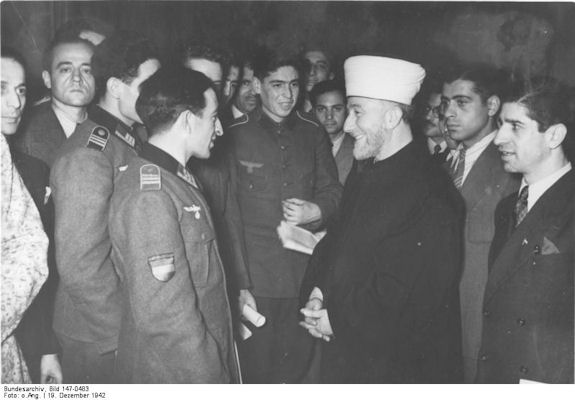
These Muslim men are a part of the Azerbaidjani Legion. Members from almost every ethnic group in the Soviet Union joined the Germans and their Allies in the struggle against Bolshevism.

The Spanish general, A Munoz Grandes who was the commander of the Azul division from Spain.

Indian voluntaries.
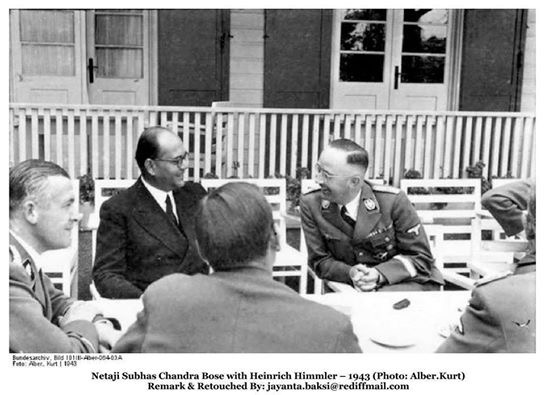
The Indian nationalist leader Subhas Chandra Bose in company with Heinrich Himmler and top SS-officers. Bose fought against British supremacy over India. He escaped British persecution and got political asylum in Nazi-Germany. .
 .
.
This picture shows the son of the chinese nationalist leader Chiang Kai Shek, Chiang Wei Guo.
He got his military education in Nazi-Germany and became a lieutenant. He was
later called back to China after the war had started in Europe. China was at war
with Japan, and Japan was allied with Germany.
 |
 |
A soldier in the Arabic section of the Nazi-German army, "Freies Arabien". What did Hitler really say about race? In his political testament he writes the following:
"Our racial pride is not aggressive except in so far as the Jewish race is concerned. We use the term Jewish race as a matter of convenience, for in reality and from the genetic point of view there is no such thing as the Jewish race. There does, however, exist a community, to which, in fact, the term can be applied and the existence of which is admitted by the Jews themselves. It is the spiritually homogeneous group, to membership of which all Jews throughout the world deliberately adhere, regardless of their whereabouts and of their country of domicile; and it is this group of human beings to which we give the title Jewish race.....The Jewish race is first and foremost an abstract race of the mind.........A race of the mind is something more solid, more durable than just a race, pure and simple...."
Danish volunteers in the Waffen SS

C.P. Kryssing was the first commander of the Danish volunteers in the Waffen SS during WW2. He was not a National Socialist and thus did not want his countrymen in the SS to be taught in that ideology which he regarded German and not Danish. He was loyal to the Danish system of government that is democracy, and thought that Danes should only participate in the international combat against bolshevism and leave the rest of the German ideology and thinking out. This attitude brought him in conflict with the leadership of SS as well as National Socialists among the Danish volunteers. The leadership of the SS had decided that all members of the Waffen SS irrespective of nationality should have the same education. He got then the choice by Himmler of leaving the SS or to be tranferred to another unit. As he did not want to return to Denmark as a failure he chose the latter. Being a skillful artillery officer educated by the Danish army he quickly rose to the rank of Brigadeführer (that is Brigadier General or Major-General) and became the commander of an entirely German artillery division named "Küste" composed of soldiers from the SS and the regular German army. Despite his nationalist arrogance towards the Germans and their political ideology he reached one of the highest ranks in the SS. Remember Hitler said several times that National Socialism knows only Germany and is not meant for export. In June 1944 he again had problems in getting along with the Germans and he filed in his resignation, but again Himmler persuaded him to stay, which he did to the end of the war.
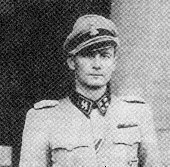
After Kryssing had left the Danish volunteers, C F Schalburg took over. Schalburg had no problems in getting along with the Germans. Born in imperial Russia (Zmilingorsk in Ukraine), the son of a Danish father and a Russian mother (maiden name: Siemenowska), he grew up in a Danish-German-Ukrainian-Russian community in Ukraine and later in Saint Petersburg. As a teenager he joined the Czarist cadet corps, but fled the country with his family after the Bolshevik take over. Taking refuge in Denmark, Schalburg enlisted in the Royal Life Guard and worked his way up to the rank of Captain.
With the outbreak of the Russo-Finnish war, Schalburg organized a Danish volunteer battalion to fight on the side of the Finns. After the German occupation of Denmark in April 1940, Schalburg became one of the first volunteers for the new SS-Standarte "Nordland". During the first nine month in Russia, he came under fire many times and led battle groups in several engagements. He carried out hazardous intelligence missions on his own initiative as well , relying on his knowledge of Russian language to take him behind enemy lines. As a result he was quickly awarded both classes of the Iron Cross. The commander of the SS Division Wiking, Gruppenführer Felix Steiner, considered him one of the most capable, intelligent and totally courageous men in the Division, and for that matter, the entire Waffen-SS.
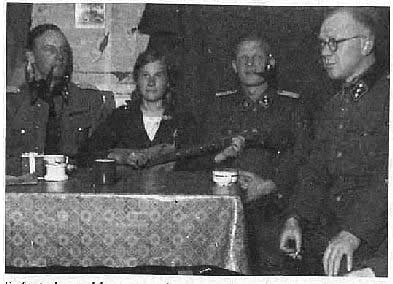
Russian speaking Schalburg (to the left) back in the country of his birth and childhood with two of his subordinated Danish officers. They are entertained by a young Russian girl from a Russian peasant family with whom they are quartered in the village Zimena.. The Danes had just arrived in Russia, and on the back of this picture from a private photo album you can read following (translated from Danish): Lenka said: One would rather think that it was a crowd of tourists that had arrived".
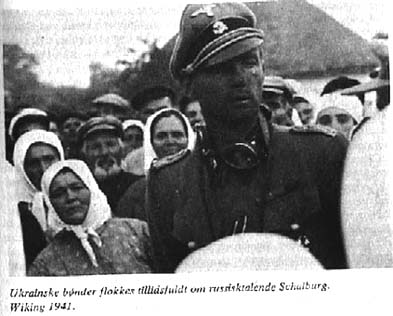
Schalburg is speaking in Russian to Ukrainian villagers. During his stay in Denmark he kept close contact to other refugees from Russia. He even converted to the Orthodox church. About his background for joining the war against Bolshevism he wrote in his diary when he was attending the military academy in Denmark:
"I felt that it was my duty to revenge my family and the country I loved. Therefore I seeked a thourough military education so that I later would be able to fight against the Bolsheviks, either in the White army or together with a country willing to fight Bolshevism. Every year I have hoped that the end of Bolshevism was near. Everyone of us ought to have died for the Czar, and it is our greatest shame that we did not do so. This can only be expiated by defeating his murderers or by dying ourselves"
How was the attitude of the leadership of SS to all these foreign volunteers within their ranks? The following is a translation of a directive from the commander of the SS Division Wiking, Felix Steiner to his officers:
Div. Commandpost
Jan. 22 1942SS Division Wiking
CORef.: Personnel management and education in wartime.
The division, more than any other, has to take into consideration keeping a watchful eye upon a humane leadership in the troop by superiors, that they deal with in the right manner.
Development of comradeship between the various replacements for the division is a slow growing process and therefore faults have a far worse effect on them than on exclusive German troops.
The most important condition for a reasonable humane leadership is a tireless and constant thoughtfulness for the ranks by the superior. He has to gain full confidence from the ranks and they must know, that he is always their comrade.
Accordingly it is the decent, true and humane management the superior principally has to bestow on his ranks.
The soldiers must like him. All superiors must therefore have strong linkage to their troops. Platoon and company commanders particularly have always to be about them, to be their standard and example as well as their confidant in all events and they must never stand humanly outside.
The more reasonable, considerable and warm-hearted a troop is lead, the more is their inner tie and fighting quality. Especially in regard to our Scandinavian volunteers all superiors are always to be with deep seriousness active in obtaining such human relations with their troops. The performance in the Division will be decisively relieved and be done by all - with more satisfaction
Signed Steiner.
And please note that there originally was a certain race criterion for admission to the SS introduced by Himmler when the SS only was parade soldiers and guard for national socialist leadership. After pressure from Hitler this criterion was abolished allready before the war, and it was never applied to foreigners.

This picture shows General Steiner on a visit to the Danish Waffen SS volunteers.
Indian volunteers in the German army